18
A woodstove was placed in the centre of the classroom to heat the room. It was a round oil barrel with legs that students crowded around in winter months as often as possible to stay warm. Students brought in wood for the fire every day. For lighting, there were kerosene or coal oil lamps and candles, which were later replaced by gas lamps and light bulbs. There were two outhouses on the school grounds: one for boys and one for girls. A water pail was usually in the corner of the classroom with a dipper and cup. There was sometimes also a bottle with a cork for drinking water. The mosquitoes were horrendous in the summertime, so students often piled mosquito corpses on their inkwells and used smudges (a grassy substance that, when burned, emits smoke) for repellent.19
School Artifacts: Barrel Woodstove (currrently in Presbyterian Church)circa 1915
Heritage Park, Fort McMurray, Alberta, Canada
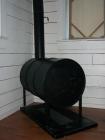 Credits:
Credits:Photographer - Sarah Robertson
Fort McMurray Historical Society - Interpretive Item
20
Virtual Tour of the Schoolhouse: Hats and mittens drying by the woodstove16 January 2012
Heritage Park, Fort McMurray, Alberta, Canada
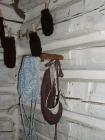 Credits:
Credits:Photographer - Sarah Robertson
Fort McMurray Historical Society - Interpretive Items
School Programs
21
Virtual Tour of the Schoolhouse: Water pail with ladle, and firewood by the woodstove16 January 2012
Heritage Park, Fort McMurray, Alberta, Canada
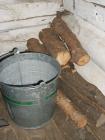 Credits:
Credits:Photographer - Sarah Robertson
Fort McMurray Historical Society - Interpretive Items
22
Memorization was an important method of study. For Geography class, students were expected to memorize the capital cities for every country in the world, as well as the names of lakes, rivers, and mountain chains. History classes often focused on the memorization of the kings and queens of England, the years in which they reigned, and their significance as individual monarchs, as well as studies in Ancient History. Mr. Stroud also recalled recitation of classic literature and passages by English poets including: the Ancient Mariner, and works by Sir Patrick Spence.23
School Artifacts: P995.10: Annie Morrison's Report Card, circa 1928circa 1928
McMurray, Alberta, Canada
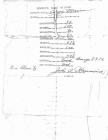 Credits:
Credits:Gloria Greig Collection
Fort McMurray Historical Society
24
Wintertime:Memories and anecdotes from Alvena Strasbourg, a Metis woman of Fort McMurray:
"Ambrose [my brother] and I started school September 1, 1927 at the brand new Peter Pond School [known as the McMurray Public School at that time]. It featured two rooms, each heated with barrel-shaped wood stoves. Toilets were outside and fifty feet away. We all walked to school. Some kids walked from Waterways which was three miles away. That was a long walk in forty below weather, on a rutted road made only by horses and dog teams. Each morning, we would be so cold when we got to school that we'd crowd around the stove, drying our mitts as we warmed up before starting classes. We would laugh, tease, and wrestle with each other, surrounded by the stink of steaming wet wool on a hot stove. Quite often, the temperature dropped to forty or fifty below. We felt lucky when it warmed to above minus twenty (Fahrenheit), equivalent to minus twenty-eight Celsius."
"When it got that cold, you could hear the snow crunching under your feet, feel the icy air pinch your nostrils, smell smoke from the nearby wood burning stoves and hear the black poplar trees exploding like gunshots from the ice in their trunks. I guess that's why people called them Bam trees! The Cree called it the season of the popping trees. The Northern lights lit the skies in swirling, dancing rays of soft greens and reds. After school, we trooped back to our warm home filled with the smell of baking bread and whatever else Momma was cooking for supper. These happy memories of Fort McMurray will stay with me forever."
"Sometimes we caught a ride home on the freight sleighs. The Ryan Brothers hauled freight and mail around town and as far north as Fort Chipewyan. Sometimes my father and Sam Delorme worked for them so they often gave us a ride if they were on the road. It was so much fun, bending our knees to take the shock of the rutted sleigh track, the icy wind whistling past our ears, and sleigh bells jingling in rhythm to the horses' trotting hooves. We bounced from side to side in the big box, chasing and falling over one another, giggling the whole time. We were a very poor community, with no exceptions for anyone, but we were very happy."
25
P2008.121.1: Syd Hawkins with a truck full of children, circa 1926circa 1926
McMurray, Alberta, Canada
 Credits:
Credits:Fort McMurray Historical Society
26
School Artifacts: Ice Skatescirca 1915
Heritage Park, Fort McMurray, Alberta, Canada
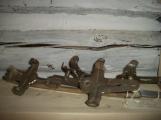 Credits:
Credits:Photographer - Sarah Robertson
Fort McMurray Historical Society - Interpretive Items
27
P2010.39.7: McKinlay, Lauboucane and Hawkins children with a snowman, circa 1930circa 1930
McMurray, Alberta, Canada
 Credits:
Credits:Winnie Hutchinson
Fort McMurray Historical Society
28
P2011.51.36: Rex Terpening cross-country skiing with a local teacher, Helen McRae, October 1933October 1933
McMurray, Alberta, Canada
 Credits:
Credits:Rex Terpening
Fort McMurray Historical Society
29
P2011.40.26: Hugh Stroud, Ron Morrison and Ann Morrison at the Christmas Concert, 19291929
McMurray, Alberta, Canada
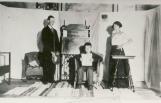 Credits:
Credits:Stroud Family Collection
Fort McMurray Historical Society
30
Attendance:Attendance was often a cause for concern in McMurray. If a student missed school, he or she needed to bring a note from home excusing their absence. Students had many responsibilities at home, and were sometimes required to skip school in order to look after younger siblings or help with the harvest. Illnesses and accidents were a common reason, particularly during the flu epidemic in 1918 that caused several fatalities among the citizens of McMurray. Tuberculosis was another fatal illness among the children. During the winter, students were sometimes unable to go to school because it was too cold to walk to school, or they were stranded by the ice break-up and unable to cross the river. Several students also joined their fathers on the trap lines for the winter trapping season.
31
P2011.40.1: Hugh Stroud delivering milk on a dog sled, circa 1929circa 1929
McMurray, Alberta, Canada
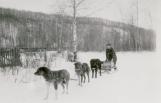 Credits:
Credits:Hugh Stroud
Fort McMurray Historical Society